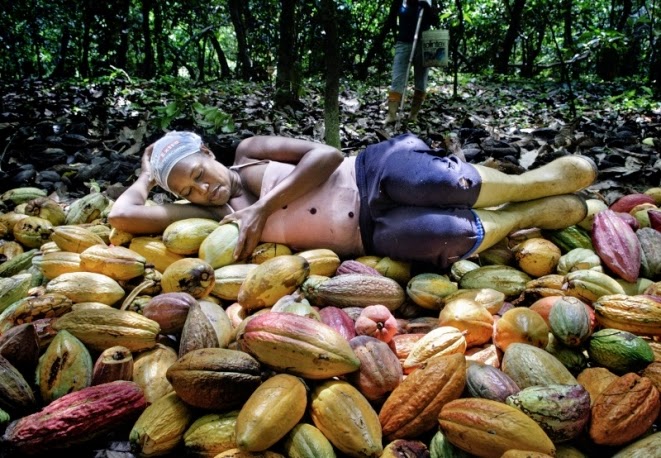Chuao, Venezuela's cultural heritage, produces the best cocoa in the
world for its aroma and taste.
The community of Chuao is located in a secluded valley of the national park Henry Pitter. Nestled between the sea and the mountains, it is possible to reach the village only by boat, or after a two day journey hiking along the paths of the park.
The cocoa company, Empresa Campesina of Chuao, is composed of local community members, mostly women. For generations, many of them have been a part of the brotherhood devoted to San Juan Bautista, whose symbolic statue portrays the saint as a child.
Since 1630 the Negro and the Indigenous population of this land have paid homage to this saint through the songs of the Sirens and the rhythms of the drums. The devotion that the people of Chuao express through song and dance is contagious, and one becomes consumed by just hearing it. The songs of the Sirens echo at work across the plantation and on the patio of the church where the cocoa is dried.
Today's culture of Chuao lives, with the imprint left by a past history of slavery . Their habits and beliefs are almost unchanged still today, where the rhythms of Afro-Caribbean drums and the Catholic religion are mixed and mingled.
Until 2009 the Italian company Amedei bought the entire annual production of Chuao cocoa for their work and to sell it on the European market. In 2010 the Venezuelan government of Chavez has rated the chocolate as a strategic asset, so he decided to take over the annual production managing it according to new government policies. Website
The community of Chuao is located in a secluded valley of the national park Henry Pitter. Nestled between the sea and the mountains, it is possible to reach the village only by boat, or after a two day journey hiking along the paths of the park.
The cocoa company, Empresa Campesina of Chuao, is composed of local community members, mostly women. For generations, many of them have been a part of the brotherhood devoted to San Juan Bautista, whose symbolic statue portrays the saint as a child.
Since 1630 the Negro and the Indigenous population of this land have paid homage to this saint through the songs of the Sirens and the rhythms of the drums. The devotion that the people of Chuao express through song and dance is contagious, and one becomes consumed by just hearing it. The songs of the Sirens echo at work across the plantation and on the patio of the church where the cocoa is dried.
Today's culture of Chuao lives, with the imprint left by a past history of slavery . Their habits and beliefs are almost unchanged still today, where the rhythms of Afro-Caribbean drums and the Catholic religion are mixed and mingled.
Until 2009 the Italian company Amedei bought the entire annual production of Chuao cocoa for their work and to sell it on the European market. In 2010 the Venezuelan government of Chavez has rated the chocolate as a strategic asset, so he decided to take over the annual production managing it according to new government policies. Website
La forza e la dedizione delle
“signore del cacao”
rende unico il sapore dei frutti che coltivano. Per la comunità di Chuao (Venezuela) la
piantagione di cacao non
è solo un lavoro che si tramanda di generazione in generazione ma un
simbolo di identità e il legame con il luogo dove è nata. Nel
1700 un gruppo di schiavi Africani vennero portati sulla costa venezuelana per
lavorare nella piantagione, da allora la comunità del villaggio di Chuao
isolata sulla costa Venezuelana raggiungibile solo via mare o attraverso i
sentieri del parco nazionale Henry Pitter, mantiene viva la sua identità
afro-discendente e le sue tradizioni legate indissolubilmente alla piantagione
di cacao. Da molti chiamata “la
valle della gente felice”, Chuao è un centro pulsante di
energia e dalla
sua terra nasce un cacao pregiato dall’aroma particolarmente intenso e dal
sapore unico. I canti delle donne echeggiano durante il lavoro nella
piantagione e il ritmo dei tamburi incalza durante le feste perché il ballo è l’espressione
dell’energia che dalla terra passa nel corpo e si libera nell’aria,
è la comunicazione diretta che crea e mantiene vivo il legame della comunità. Discendenti
di un gruppo di schiavi portati dall’Africa per coltivare la piantagione nel
XVII secolo il cacao è il simbolo (concreto e reale) dell’identità della
comunità, su questa terra la comunità incontra il suo santo patrono San Juan
Bautista. La festa del santo raffigurato
bambino, accudito durante l’anno dalle stesse donne che lavorano nella
piantagione, coincide la raccolta principale dell’anno. Durante
i giorni di festa la comunità si riunisce e le donne cantano in onore al santo
per un buon raccolto, e per mantenere vive le antiche tradizioni e lo spirito
della comunità. Veronica Adriani è nata a Roma. Dopo aver terminato gli
studi universitari in Storia del Cinema e la formazione fotografica , Veronica
Adriani spinta dall’interesse verso culture diverse, cerca paesi nuovi dove
spostarsi e vivere per periodi brevi. Si ferma per circa 2 anni a New York dove
affianca presso MVphoto, laboratorio di stampa in B/N, Jim Megargee, collabora
inoltre con l’archivio dell’agenzia Magnum e la fotografa Alessandra
Sanguinetti.
Dopo aver
fotografato storie locai inizia a lavorare su di un unico filone; da oltre un
anno porta avanti un progetto sulle popolazioni che coltivano cacao “La via del
cacao mi porta a condividere la quotidianità delle persone che incontro”
All images © Veronica Adriani












.jpg)
.jpg)
.jpg)
.jpg)
.jpg)
.jpg)
.jpg)
.jpg)
.jpg)
.jpg)
Nessun commento:
Posta un commento